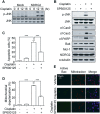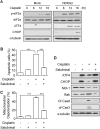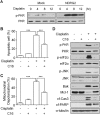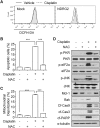NDRG2 contributes to cisplatin sensitivity through modulation of BAK-to-Mcl-1 ratio
- PMID: 29348517
- PMCID: PMC5833685
- DOI: 10.1038/s41419-017-0184-3
NDRG2 contributes to cisplatin sensitivity through modulation of BAK-to-Mcl-1 ratio
Abstract
The downregulation of N-Myc downstream-regulated gene 2 (NDRG2) is known to be associated with the progression and poor prognosis of several cancers. Sensitivity to anti-cancer may be associated with a good prognosis in cancer patients, and NDRG2, which is induced by p53, sensitizes the cells to chemotherapy. However, the unique function of NDRG2 as an inducer of apoptosis under chemotreatment has not been sufficiently studied. In this study, we investigated the role of NDRG2 in chemo-sensitivity, focusing on cisplatin in U937 histiocytic lymphoma, which has the loss-of-functional mutation in p53. NDRG2 promoted the sensitivity to cisplatin through the modulation of the BAK-to-Mcl-1 ratio. The degradation of Mcl-1 and increase in BAK were mediated by JNK activation and the eIF2α/p-eIF2α pathway, respectively, which depended on PKR activation in NDRG2-overexpressed U937 (U937-NDRG2) cells. NOX5 was highly expressed in U937-NDRG2 cells and contributed to ROS production after cisplatin treatment. ROS scavenging or NOX5-knockdown successfully inhibited the sensitivity of U937-NDRG2 cells to cisplatin. Taken together, these findings indicate that NDRG2 contributed to the increased sensitivity to ciplatin through the modulation of Bak-to-Mcl-1 ratio regulated by NOX5-ROS-PKR pathway; therefore, we suggest that NDRG2 may be a molecular target for improving the efficacy of drug treatment in cancer patients.
Conflict of interest statement
The authors declare that they have no conflict of interest.
Figures







Similar articles
-
N-myc Downstream-Regulated Gene 2 (NDRG2) Function as a Positive Regulator of Apoptosis: A New Insight into NDRG2 as a Tumor Suppressor.Cells. 2021 Oct 4;10(10):2649. doi: 10.3390/cells10102649. Cells. 2021. PMID: 34685629 Free PMC article. Review.
-
NDRG2 Sensitizes Myeloid Leukemia to Arsenic Trioxide via GSK3β-NDRG2-PP2A Complex Formation.Cells. 2019 May 22;8(5):495. doi: 10.3390/cells8050495. Cells. 2019. PMID: 31121982 Free PMC article.
-
Cisplatin-induced apoptosis in non-small-cell lung cancer cells is dependent on Bax- and Bak-induction pathway and synergistically activated by BH3-mimetic ABT-263 in p53 wild-type and mutant cells.Biochem Biophys Res Commun. 2016 Apr 29;473(2):490-6. doi: 10.1016/j.bbrc.2016.03.053. Epub 2016 Mar 18. Biochem Biophys Res Commun. 2016. PMID: 26996126
-
Knock-down of NDRG2 sensitizes cervical cancer Hela cells to cisplatin through suppressing Bcl-2 expression.BMC Cancer. 2012 Aug 27;12:370. doi: 10.1186/1471-2407-12-370. BMC Cancer. 2012. PMID: 22920753 Free PMC article.
-
MCL-1 is the key target of adjuvant chemotherapy to reverse the cisplatin-resistance in NSCLC.Gene. 2016 Aug 10;587(2):147-54. doi: 10.1016/j.gene.2016.04.054. Epub 2016 Apr 29. Gene. 2016. PMID: 27138804
Cited by
-
Non-coding RNA and Drug resistance in cholangiocarcinoma.Noncoding RNA Res. 2023 Nov 12;9(1):194-202. doi: 10.1016/j.ncrna.2023.11.003. eCollection 2024 Mar. Noncoding RNA Res. 2023. PMID: 38125756 Free PMC article. Review.
-
NOX5: Molecular biology and pathophysiology.Exp Physiol. 2019 May;104(5):605-616. doi: 10.1113/EP086204. Epub 2019 Mar 18. Exp Physiol. 2019. PMID: 30801870 Free PMC article. Review.
-
The delivery of N-myc downstream-regulated gene 2 (NDRG2) self-amplifying mRNA via modified lipid nanoparticles as a potential treatment for drug-resistant and metastatic cancers.Med Rev (2021). 2024 Apr 1;4(3):235-238. doi: 10.1515/mr-2024-0004. eCollection 2024 Jun. Med Rev (2021). 2024. PMID: 38919399 Free PMC article.
-
N-myc Downstream-Regulated Gene 2 (NDRG2) Function as a Positive Regulator of Apoptosis: A New Insight into NDRG2 as a Tumor Suppressor.Cells. 2021 Oct 4;10(10):2649. doi: 10.3390/cells10102649. Cells. 2021. PMID: 34685629 Free PMC article. Review.
-
NDRG2 gene expression pattern in ovarian cancer and its specific roles in inhibiting cancer cell proliferation and suppressing cancer cell apoptosis.J Ovarian Res. 2020 Apr 28;13(1):48. doi: 10.1186/s13048-020-00649-0. J Ovarian Res. 2020. PMID: 32345304 Free PMC article.
References
Publication types
MeSH terms
Substances
LinkOut - more resources
Full Text Sources
Other Literature Sources
Molecular Biology Databases
Research Materials
Miscellaneous

